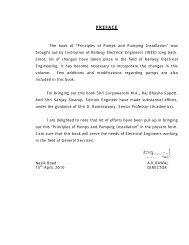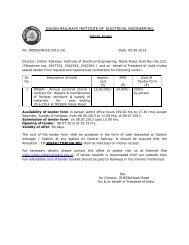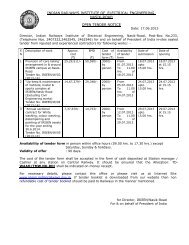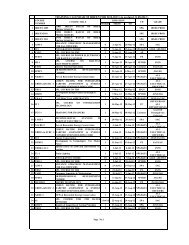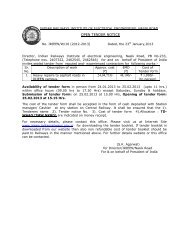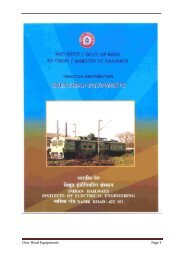remote control equipment - Indian Railways Institute of Electrical ...
remote control equipment - Indian Railways Institute of Electrical ...
remote control equipment - Indian Railways Institute of Electrical ...
Create successful ePaper yourself
Turn your PDF publications into a flip-book with our unique Google optimized e-Paper software.
7.1 Introduction<br />
REMOTE CONTROL EQUIPMENT<br />
A Remote Contral Centre (RCC) is set up near the Traffic Control Office on each Division<br />
having electric traction, to work in close liaison with the traffic <strong>control</strong>. The RCC includes the<br />
main <strong>control</strong> room, <strong>equipment</strong> room Uninterrupted Power Supply (UPS) room. Remote Control<br />
Laboratory and Battery Room and is the nerve centre <strong>of</strong> the Traction Power Control<br />
Types Of Equipment<br />
The FMVFT <strong>equipment</strong> (stronger type <strong>equipment</strong>) was in use for all electrification schemes<br />
prior to 1980. Being mainly all relay system. the <strong>equipment</strong> has become outdated. Salient<br />
features <strong>of</strong> the system can be seen in ealier print <strong>of</strong> this book.<br />
The SCADA <strong>equipment</strong> based on State <strong>of</strong> the art technology has come into use after 1980.<br />
Considering the fast growth and development <strong>of</strong> computer based <strong>equipment</strong>. newer types with<br />
enhanced capabilities and new makes are being introduced. Addional facilities at each new<br />
RCC is also natural as new features get incorporated.<br />
7.2 SCADA - TRENDS<br />
Supervisory Control is generally defined; “ as a form <strong>of</strong> <strong>remote</strong> <strong>control</strong> comprising an<br />
arrangement for selective <strong>control</strong> <strong>of</strong> <strong>remote</strong>ly located units, by electrical means, over one or<br />
more common interconnecting channels”.<br />
In the Electric Power industry, supervisory <strong>control</strong> may be used in as simple an<br />
application as <strong>control</strong>ling a single distribution feeder. In its most complex form, referred to as<br />
Supervisory Control and Data Acquisition (SCADA) system, it may <strong>control</strong> all generation,<br />
transmission and distribution over a wide geographical area, from one centralized location.<br />
There were undoubtedly many methods <strong>of</strong> <strong>remote</strong> <strong>control</strong> invented by early pioneers in<br />
the supervisory <strong>control</strong> field, and long since forgotten. For sure, SCADA did not begin with<br />
electronic sensors and analog to digital coverters; but with a person reading a measurement<br />
and taking some mechanical <strong>control</strong> action as a result <strong>of</strong> that measurement.<br />
From 1900 to early 1920’s many varieties <strong>of</strong> <strong>remote</strong> <strong>control</strong> and supervisory systems<br />
were developed. Most <strong>of</strong> these, however were <strong>of</strong> one class or the other i.e. either <strong>remote</strong><br />
<strong>control</strong> or <strong>remote</strong> supervision. Perhaps one <strong>of</strong> the earliest forerunners <strong>of</strong> modern supervisory<br />
<strong>control</strong> was a system designed by John Harlow in 1921. This system automatically detected a<br />
change <strong>of</strong> status at a <strong>remote</strong> station and reported this change to a <strong>control</strong> centre. In 1923,<br />
John Bellamy and Rodney Richardson developed a <strong>remote</strong> <strong>control</strong> system employing an<br />
equivalent <strong>of</strong> our modern “Check-before-operation” technique to ensure the validity <strong>of</strong> a<br />
selected <strong>control</strong> point before actual <strong>control</strong> was inintiated.<br />
Perhaps the first logging system was designed in 1927. This system monitored<br />
information from a <strong>remote</strong> location and printed any change in the status <strong>of</strong> the <strong>equipment</strong>.<br />
together with the time and date when the change took place.<br />
At this time, <strong>of</strong> course, there was a little choice in the type <strong>of</strong> components available,<br />
thus, all <strong>of</strong> these systems were electro-mechanical.<br />
121






